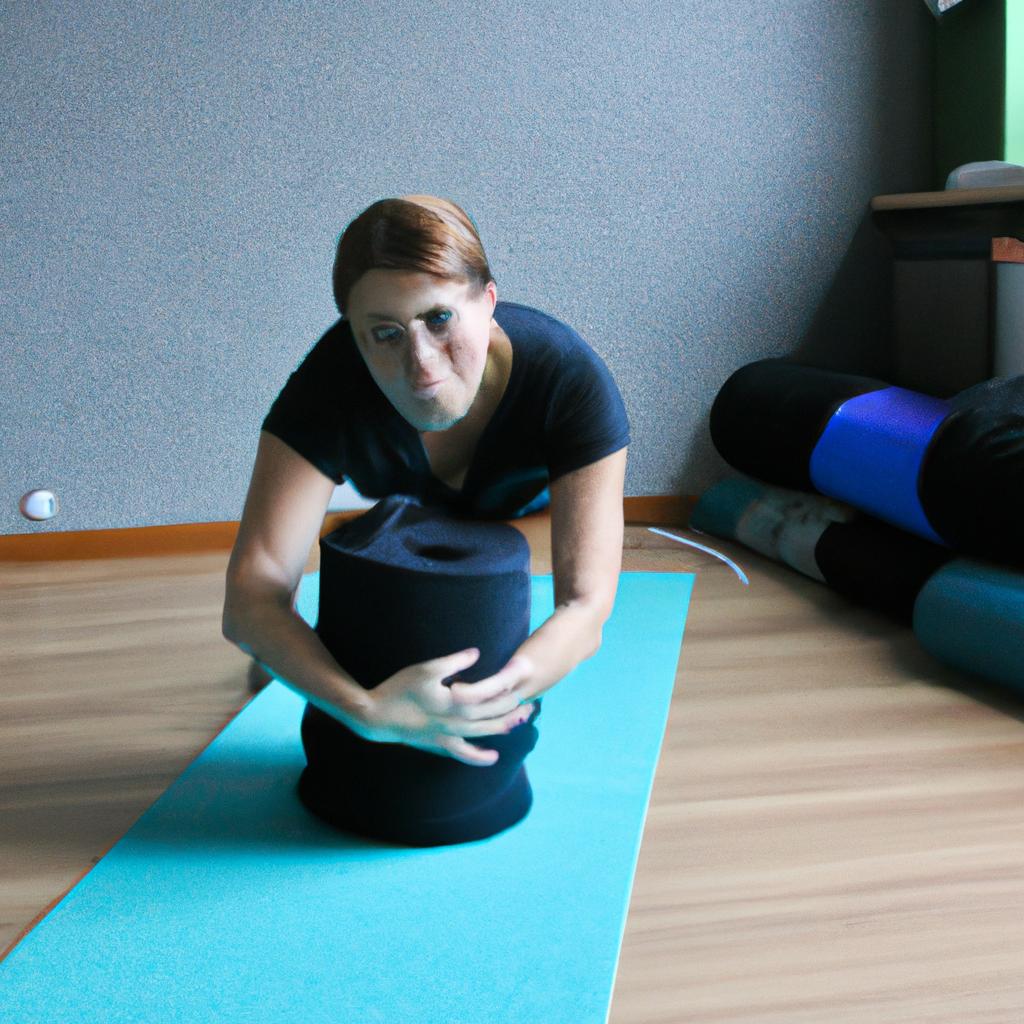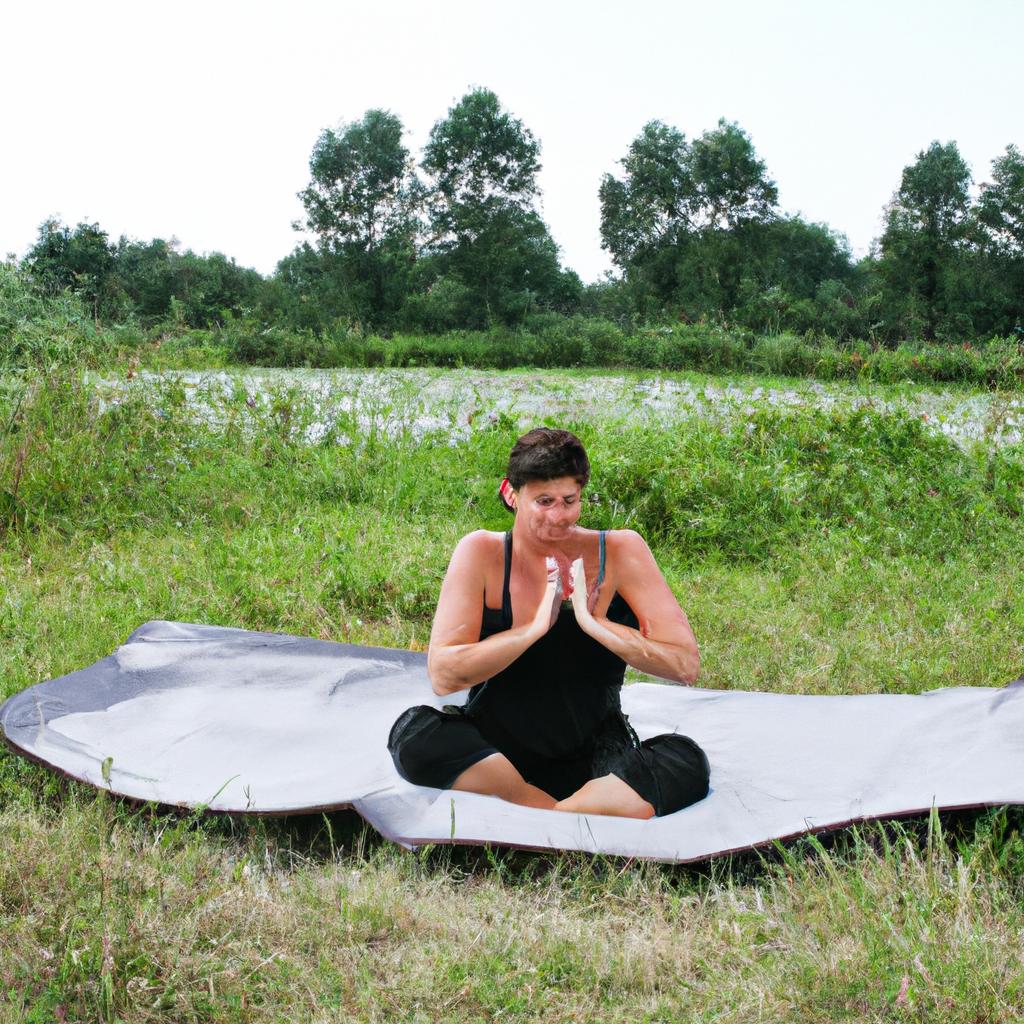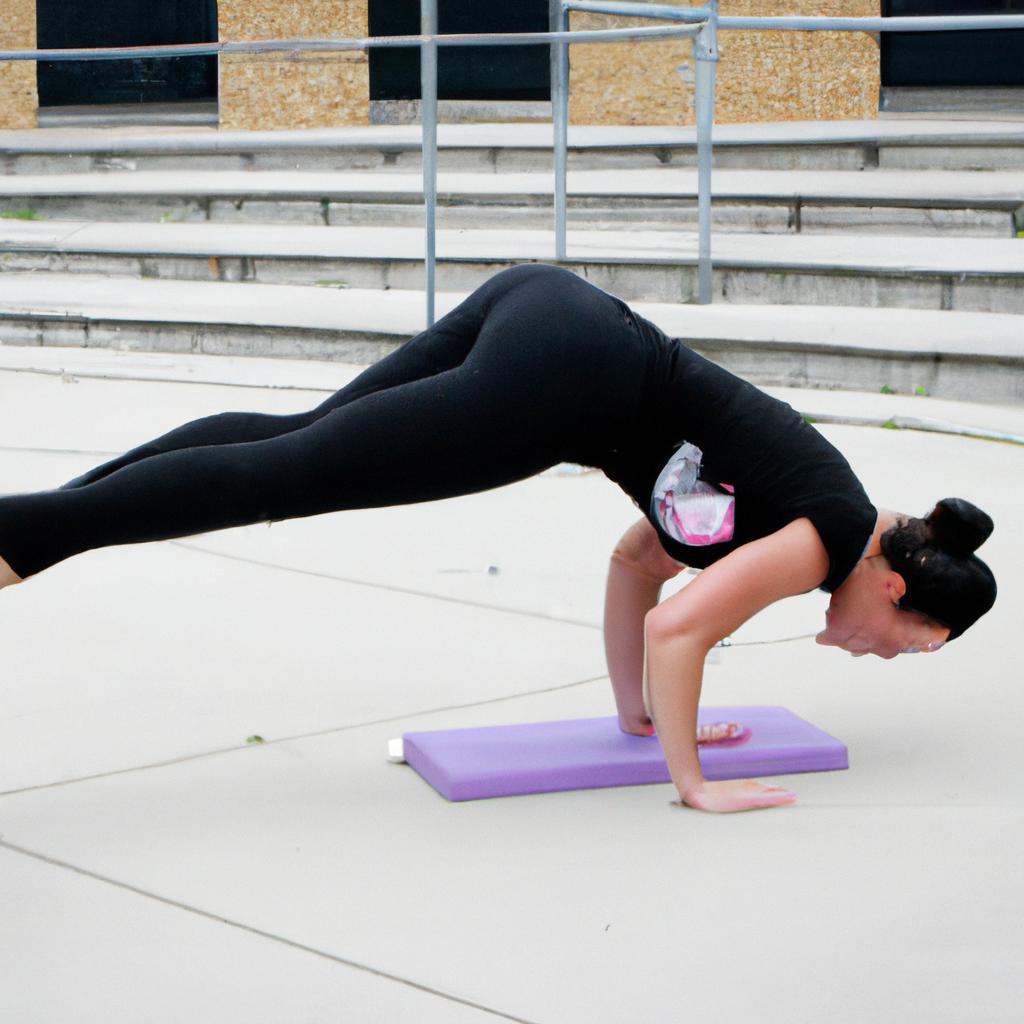Introduction
Yoga has gained immense popularity in recent years, with millions of people worldwide embracing its physical and mental benefits. Whether you are a seasoned practitioner or just starting out on your yoga journey, one essential item that cannot be overlooked is the yoga mat. The right yoga mat can greatly enhance your practice by providing stability, comfort, and support during various poses and movements. However, choosing the perfect yoga mat can be a daunting task due to the overwhelming number of options available in the market. This guide aims to assist individuals in making an informed decision when selecting their ideal yoga mat.
Consider this scenario: Sarah, a dedicated yogi who practices daily at her local studio, recently decided to purchase a new yoga mat. She walks into a store filled with rows upon rows of mats in different colors, thicknesses, materials, and price ranges. Overwhelmed by the choices before her, she realizes that finding the perfect yoga mat is not as simple as it seems. Like many others faced with similar predicaments, Sarah understands the importance of investing in a high-quality mat that suits her unique needs and preferences. In order to help individuals like Sarah make an informed decision amidst countless options available today, this comprehensive guide will explore key factors to consider when choosing the perfect yoga mat.
-
Material: The material of the yoga mat plays a crucial role in its performance and durability. Common materials used for yoga mats include PVC, rubber, TPE (Thermoplastic Elastomer), and natural fibers like cork or jute. Each material has its own benefits and drawbacks, so it’s important to choose one that suits your preferences, such as grip, eco-friendliness, cushioning, and ease of maintenance.
-
Thickness: The thickness of a yoga mat determines its level of cushioning and support. Thicker mats provide more comfort for sensitive joints but may compromise stability in standing poses. Thinner mats offer better stability but may not be as comfortable during seated or lying positions. Consider your individual needs and the type of practice you engage in when selecting the appropriate thickness.
-
Texture: The texture of a yoga mat affects its grip on different surfaces and provides traction for your hands and feet. Smooth mats are ideal for practices that involve fluid movements, while textured mats offer better grip for challenging poses that require more stability.
-
Size: Yoga mats come in various sizes, so it’s essential to choose one that accommodates your body size comfortably. Standard yoga mats are typically 24 inches wide by 68 inches long, but taller individuals may prefer longer options to ensure full coverage during their practice.
-
Portability: If you plan on carrying your yoga mat to classes or traveling with it frequently, consider its weight and portability features. Lightweight mats are easier to transport but might sacrifice cushioning or durability compared to heavier ones.
-
Eco-Friendliness: For environmentally conscious individuals, choosing an eco-friendly yoga mat made from sustainable materials can align with their values. Look for mats that are free from harmful chemicals like phthalates or heavy metals and opt for biodegradable or recyclable options whenever possible.
-
Price: While budget is an important consideration for many, it’s essential to strike a balance between quality and affordability. Investing in a high-quality yoga mat that meets your needs can enhance your practice and last longer, ultimately providing better value for money.
Conclusion
Choosing the perfect yoga mat may seem overwhelming at first but considering factors like material, thickness, texture, size, portability, eco-friendliness, and price can help you make an informed decision. Remember that everyone’s preferences are unique, so take the time to try out different mats if possible or read reviews from trusted sources to find one that suits your practice style and enhances your overall experience on the mat.
Understanding the Different Types of Yoga Mats
Imagine you are a dedicated yogi, ready to embark on your daily practice. As you unroll your mat, you notice that it feels slippery and provides inadequate cushioning for your joints. Frustrating, isn’t it? This scenario highlights the importance of choosing the perfect yoga mat tailored to your specific needs and preferences.
To begin with, let’s explore the different types of yoga mats available in today’s market. One popular option is the PVC or vinyl mat, which offers excellent durability and grip. However, these mats tend to be less eco-friendly due to their synthetic composition. On the other hand, natural rubber mats provide superior traction and resilience while being more environmentally friendly. Additionally, there are cork mats known for their antimicrobial properties and sustainable sourcing.
When considering purchasing a yoga mat, it is essential to evaluate various factors:
- Thickness: A thicker mat can offer better support for sensitive joints.
- Texture: Some individuals prefer a smooth surface, while others find textured mats improve grip during challenging poses.
- Weight: If you frequently travel with your mat or attend classes outside of your home studio, opting for a lightweight design may be advantageous.
- Price range: Determine how much you are willing to invest in a quality yoga mat that aligns with both your budget and requirements.
To further illustrate this information visually:
| Mat Type | Pros | Cons |
|---|---|---|
| PVC/Vinyl | Durable | Less eco-friendly |
| Natural Rubber | Excellent grip | May have odor |
| Cork | Antimicrobial | Less common |
Now armed with an understanding of different types of yoga mats and key considerations when selecting one, you can move forward in assessing your personal needs and preferences without compromising comfort or functionality.
Assessing Your Needs and Preferences
Now that we have explored the various types of yoga mats, let’s delve deeper into assessing your needs and preferences. To illustrate this process, consider the case of Sarah, a dedicated yogi in search of her ideal mat. Sarah practices hot yoga twice a week and values sustainability in her purchasing decisions.
Firstly, it is crucial to determine the key factors that will guide your choice. Evaluate your practice style, frequency, and intensity to identify specific requirements for your mat. Consider aspects such as grip, cushioning, durability, and portability. Each factor contributes to an optimal experience on the mat. For instance, if you engage in vigorous vinyasa flows or prefer a dynamic practice like power yoga, prioritizing excellent grip becomes essential for stability during transitions between poses.
Secondly, take into account any personal preferences or sensitivities you may have. Some individuals prefer natural materials due to their eco-friendly properties or sensory preference over synthetic options. Others might prioritize easy maintenance or lightweight mats for travel convenience. By aligning these individual preferences with available choices in the market, you can narrow down your options effectively.
To further aid in decision-making while maintaining an objective approach, here are four important considerations:
- Material: Look for sustainable alternatives like natural rubber or organic cotton.
- Size: Choose a size that provides ample space for movement without being excessively large.
- Thickness: Opt for appropriate thickness based on your comfort level and requirement for joint support.
- Price range: Determine a budget that suits both your financial capabilities and desired quality.
By referring to these guidelines and considering each point carefully against your own criteria, you will be well-equipped to make an informed decision when selecting a yoga mat.
As we move forward in our exploration of choosing the perfect yoga mat, it is vital to pay attention to another aspect: thickness and density. This consideration significantly impacts both comfort and stability during practice. Stay tuned to discover how thickness and density play a crucial role in optimizing your yoga experience.
Considering the Thickness and Density
Imagine this scenario: Sarah, an avid yogi who practices yoga daily, recently found herself struggling to maintain her balance during certain poses. She noticed that her current yoga mat was thin and slippery, making it difficult for her to stay grounded. Realizing the need for a new mat, Sarah began considering various factors that would help her choose the perfect one.
When searching for your ideal yoga mat, there are several essential aspects to consider. Firstly, think about the type of yoga you primarily practice. Are you more inclined towards gentle flow or power-packed hot yoga sessions? Different styles of yoga demand different levels of grip and support from a mat. For instance:
- If you prefer low-intensity workouts like Yin Yoga or Restorative Yoga, opt for a thicker and softer mat that provides extra cushioning.
- Conversely, if you engage in vigorous forms such as Ashtanga or Vinyasa Yoga, a thinner but denser mat will offer better stability and control.
Secondly, take into account your body’s specific needs. Do you experience joint pain or have sensitive knees? In these cases, choosing a mat with additional padding can provide much-needed comfort and prevent strain on your joints. Furthermore, consider any allergies or sensitivities you may have; some mats are made with natural materials like rubber or jute while others utilize synthetic alternatives.
Lastly, factor in personal preferences such as color options and design aesthetics. While not directly impacting your practice itself, having a visually pleasing mat can create a positive ambiance during your yoga sessions. Additionally, ensure that the size of the mat suits your height and allows ample space for movement without restriction.
To summarize:
- Determine the style of yoga you practice most frequently
- Consider any physical limitations or conditions that require specific features in a mat
- Take into account personal preferences regarding color choices and design aesthetics
With these considerations in mind, you can now move on to the next step of selecting your ideal yoga mat: evaluating the material and texture. This will further refine your search by ensuring that you choose a mat that not only accommodates your needs but also enhances your overall practice experience.
Evaluating the Material and Texture
Now, let’s delve deeper into this aspect to help you make an informed decision.
Imagine you are a beginner yogi who prefers gentle practices like Hatha or Yin Yoga. You might benefit from a thicker mat that provides additional cushioning and support for your joints during long-held poses. On the other hand, if you’re an experienced practitioner who enjoys more vigorous styles such as Ashtanga or Vinyasa Flow, a thinner mat with higher density can offer better stability and grip for faster-paced movements.
When evaluating the thickness and density of yoga mats, keep in mind the following considerations:
- Comfort: A thicker mat generally offers greater comfort, especially if you have sensitive knees or wrists. It can provide extra padding between your body and the floor, reducing discomfort during longer sessions.
- Portability: Thinner mats tend to be lighter and easier to carry around, making them ideal for frequent travelers or those who attend classes outside their homes.
- Durability: Mats with higher density often last longer due to their ability to withstand wear and tear over time. This makes them suitable for regular use without losing their shape or integrity.
- Stability: Thicker mats offer enhanced stability, making balancing poses easier by providing a solid foundation beneath your feet.
To further illustrate these points, here’s a table comparing two hypothetical yoga mats:
| Mat | Thickness (mm) | Density (kg/m³) | Comfort Level |
|---|---|---|---|
| Gentle Yogi | 6 | 70 | High |
| Dynamic Warrior | 3 | 100 | Moderate |
As seen in this table, the “Gentle Yogi” mat with its higher thickness and lower density provides a high level of comfort, making it suitable for gentle practices. On the other hand, the “Dynamic Warrior” mat offers moderate comfort due to its thinner profile but compensates with a higher density that enhances stability during dynamic movements.
In summary, when choosing a yoga mat, consider the thickness and density that aligns with your practice style and personal preferences. Now let’s move on to exploring another essential aspect: evaluating the material and texture of yoga mats in order to find the perfect one for you.
Transitioning into Exploring Eco-friendly and Sustainable Options
Exploring Eco-friendly and Sustainable Options
Section H2: Choosing the Perfect Yoga Mat: Your Essential Guide
Having evaluated the material and texture of yoga mats, let us now turn our attention to exploring eco-friendly and sustainable options. Making an environmentally conscious choice not only aligns with our personal values but also contributes to a greener planet.
To understand the importance of choosing eco-friendly and sustainable yoga mats, consider this hypothetical scenario: Anna, an avid yogi, decides to replace her old mat. She’s aware that traditional PVC mats are harmful to both human health and the environment due to their non-biodegradable nature. Seeking a more responsible alternative, she dives into exploring eco-friendly options available in the market.
When considering which eco-friendly yoga mat to choose, it is crucial to keep these factors in mind:
-
Material Composition:
- Look for mats made from natural materials such as rubber or jute.
- Avoid mats containing synthetic materials like polyvinyl chloride (PVC) or toxic chemicals like phthalates.
-
Production Process:
- Opt for mats manufactured using sustainable practices that minimize waste and energy consumption.
- Seek out brands committed to ethical sourcing and fair labor practices.
-
Durability and Longevity:
- Select mats designed for durability, ensuring they can withstand regular use without wearing down quickly.
- Consider investing in high-quality mats that offer extended warranties or guarantees against wear-and-tear issues.
-
Disposal Options:
- Choose a mat that is biodegradable or recyclable at the end of its lifespan.
- Research local recycling programs or facilities that accept yoga mats for proper disposal.
By employing these guidelines when selecting an eco-friendly yoga mat, you contribute significantly towards minimizing your carbon footprint while indulging in your practice sustainably.
Transition sentence into subsequent section about “Setting a Budget and Making the Final Decision”:
With a clearer understanding of eco-friendly options, let us now delve into the final steps: setting a budget and making the ultimate decision on the perfect yoga mat for your needs.
Setting a Budget and Making the Final Decision
As we delve deeper into choosing the perfect yoga mat, let’s now shift our focus to setting a budget and making the final decision. By considering your financial constraints and weighing various factors, you can make an informed choice that aligns with both your needs and values.
Setting a Budget:
When it comes to purchasing a yoga mat, prices can vary significantly. Setting a budget allows you to narrow down your options and find a mat that suits not only your practice but also your wallet. Consider these steps when determining your budget:
- Evaluate affordability: Determine how much you are willing to spend on a yoga mat by assessing your personal finances and priorities.
- Research price ranges: Explore different brands and types of mats to get an idea of their typical costs.
- Prioritize features within your budget: Decide which qualities are most important to you in a yoga mat – whether it be thickness, durability, or sustainability – and allocate funds accordingly.
- Look for deals or discounts: Keep an eye out for sales or promotions that may allow you to purchase a higher-quality mat within your budget.
| Feature | Price Range |
|---|---|
| Thickness | $10 – $50 |
| Material | $15 – $80 |
| Durability | $20 – $60 |
| Sustainability | $30 – $100 |
Making the Final Decision:
With considerations such as eco-friendliness explored in the previous section, along with setting a budget, it is time to finalize your decision regarding the ideal yoga mat for you. Here are some key points to keep in mind during this process:
- Reflect on preferences: Consider what characteristics matter most to you personally – whether it’s comfort, grip, cushioning, or any other aspect that enhances your practice.
- Test and compare options: If possible, try out different mats in a store or borrow from friends to assess their performance and suitability for your needs.
- Seek recommendations: Reach out to fellow yogis or trusted instructors for suggestions based on their experiences and expertise.
- Read reviews: Take advantage of online resources where users provide feedback on various yoga mats. These insights can help you make more informed decisions.
By following these steps and considering the factors discussed throughout this guide, you will be well-equipped to choose a yoga mat that not only fits within your budget but also meets all your requirements.
Note: Remember that choosing a yoga mat is a personal decision influenced by individual preferences, so take the time to find what works best for you.
 Buzzez
Buzzez



